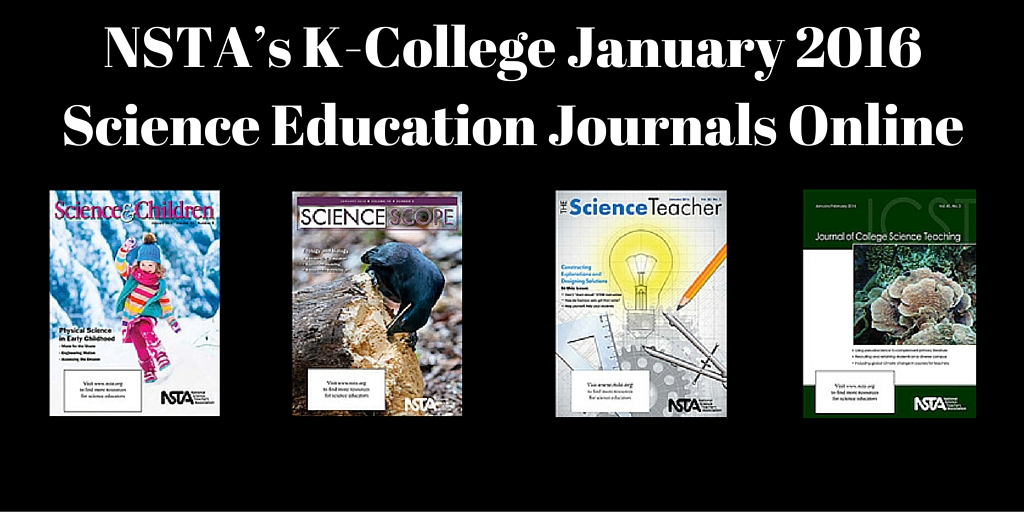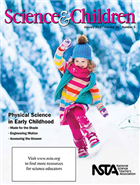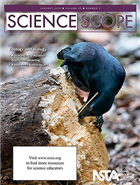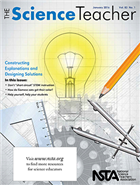NSTA’s K-College January 2016 Science Education Journals Online
By Korei Martin
Posted on 2016-01-06
Looking for ways to engage preschool students in physical science? Are your students curious as to how animals communicate and make decisions? Want to expand your students interest in engineering? Looking for new ways for undergraduate teaching assistants to work with college students in entry-level STEM courses? The January K–College journals from the National Science Teachers Association (NSTA) have the answers you need. Written by science teachers for science teachers, these peer-reviewed journals are targeted to your teaching level and are packed with lesson plans, expert advice, and ideas for using whatever time/space you have available. Browse the January issues; they are online (see below), in members’ mailboxes, and ready to inspire teachers!
Starting in preschool, teachers can engage students in physical science through creative, hands-on lessons. This issue of S&C delves into physical science lessons that involve derby cars, UV-sensitive lizards, and more.
Featured articles (please note, only those marked “free” are available to nonmembers without a fee):
- Free – Addressing Three Common Myths About the Next Generation Science Standards
- Assessing the Unseen
- Free – Editor’s Note: Early Childhood Physical Science
- How We Know What We Know
- Made for the Shade
- Seeing the Solar System Through Two Perspectives
- Table of Contents
New Caledonian crows are master tool makers and users. They have even been known to stash their favorite tools in the hollows of trees so they can be retrieved and reused for another meal. Check out this issue’s Tried and True column for a crow-foraging activity that is sure to engage and inform your students as they explore animal communication, cooperation, and decision-making.
Featured articles (please note, only those marked “free” are available to nonmembers without a fee):
- A Biomedical Engineering Twist to Science Fairs
- Free – Addressing Three Common Myths About the Next Generation Science Standards
- Eco-Choices: Understanding the Complex Consequences of Local Decisions
- Free – Editor’s Roundtable: More Than Just a Chart
- Modeling Ecosystems
- Outbreak! Cells, Pathogens, and Disease
- Table of Contents
Science is all about asking questions and constructing explanations, while engineering focuses on defining problems and designing solutions. Think of science as the quest for timeless truths and engineering as the search for design solutions to problems rooted in a particular time and situation. To be sure, there is overlap. Scientists often must complete engineering tasks such as designing experimental apparatus and testing prototypes, and engineers sometimes explore new phenomena and develop scientific models. In our schools we need to educate students about engineering careers, especially our young women, who are dramatically underrepresented in engineering fields. We cannot waste precious human capital by creating another generation of students who can say, “I have no idea what an engineer is.”
Featured articles (please note, only those marked “free” are available to nonmembers without a fee):
- Addressing Three Common Myths About the Next Generation Science Standards
- Free – Don’t “Short Circuit” Stem Instruction
- Free – Editor’s Corner: Constructing Explanations and Designing Solutions
- Health Wise: Spotting Depression in High School Students
- Help Yourself, Help Your Students
- How Do Siamese Cats Get Their Color?
- Table of Contents
Journal Of College Science Teaching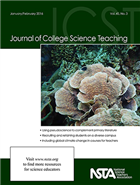
Read about a study that investigated the learning gap between students with strong prerequisite skills and students with weak prerequisite skills and concluded that these skills are critical to subsequent learning. See the Research and Teaching article that examines the development of peer mentoring skills and deepening of content knowledge by trained undergraduate teaching assist
ants working with students in entry-level STEM courses. And don’t miss the Case Study that looks at a flipped classroom approach in which students both produce and watch videos in preparation for class.
Featured articles (please note, only those marked “free” are available to nonmembers without a fee):
- Crossing Boundaries in Undergraduate Biology Education
- Point of View: Predictably Unpredictable
- Research and Teaching: Computational Methods in General Chemistry: Perceptions of Programming, Prior Experience, and Student Outcomes
- Research and Teaching: Correlations Between Students’ Written Responses to Lecture-Tutorial Questions and Their Understandings of Key Astrophysics Concepts
- Research and Teaching: Development of Undergraduate Teaching Assistants as Effective Instructors in STEM Courses
- Free – Strategies to Recruit and Retain Students in Physical Science and Mathematics on a Diverse College Campus
- Table of Contents
Get these journals in your mailbox as well as your inbox—become an NSTA member!
The mission of NSTA is to promote excellence and innovation in science teaching and learning for all.
Follow NSTA
Disclaimer: The views expressed in this blog post are those of the author(s) and do not necessarily reflect the official position of the National Science Teaching Association (NSTA).


